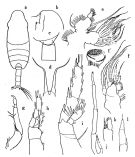
issued from : O. Tanaka
in Publ. Sero Mar. Biol. Lab., 1960, VIII (1). [p.105, Fig.90]. As
Amallophora serrata.
Male (from Suruga Bay, Japan): a, habitus (dorsal); b, forehead (lateral); c, last rhoracic segment and 1st and 2nd urosomal segment (lateral left side); d, rostrum (anterior aspect); e, Mx1; f, Mx2: f' button-shaped sensory appendage; g, Mxp; h, P1; i, P2; j, P5; k, distal segment of left P5; l, distal segment of right P5.
Nota: Head and 1st thoracic segment separate, 4th and 5th incompletely fused.
Frontal margin of the head rounded in dorsal aspect, but slightly hollowed in lateral aspect
Rostral filaments slender and long -, without any trace of articulation with the basal part.
Abdomen 5-segmented. The abdominal segments and furca in the proportional lengths 10 : 31 : 29 : 20 : 2 : 8 = 100.
Genital opening is on the left distal margin.
Caudal rami about as long as wide.
A2 exopodite 1.2 times as long as the endopodite.
Md with a voluminous 2nd basal segment.
Mx1 as that of the male of
X. greeni.
Mx2: 3 usual slender setae, 6 small bud-like sensory setae, and one large button-shaped appendage with ciliated head, on the endopod; the outer lobes have each long flexible plumose setae.
Mxp with reduced number of setae on the basal segment; the 2nd basal segment furnished with hairs on the anterior proximal margin.
Right P5 very short, terminal segment with an apical spine, 3rd segment with a small spine on the outer distal margin. Left P5 reaching the distal end of the furca, terminal segment small and serrated on the distal margin, the inner proximal margin is furnished with hairs; 4th segment with a tuft of hairs on the inner distal angle; 3rd with a small spine on the outer distal margin; 2nd with a rudimentary endopod on the inner distal margin.
Remarks: In the P2 to P4 the terminal spine of the exopodite is distorted as figured by Sewell (1929, p.214, fig.f') and is furnished with teeth of varying sizes but they are more finely arranged in the present male.




